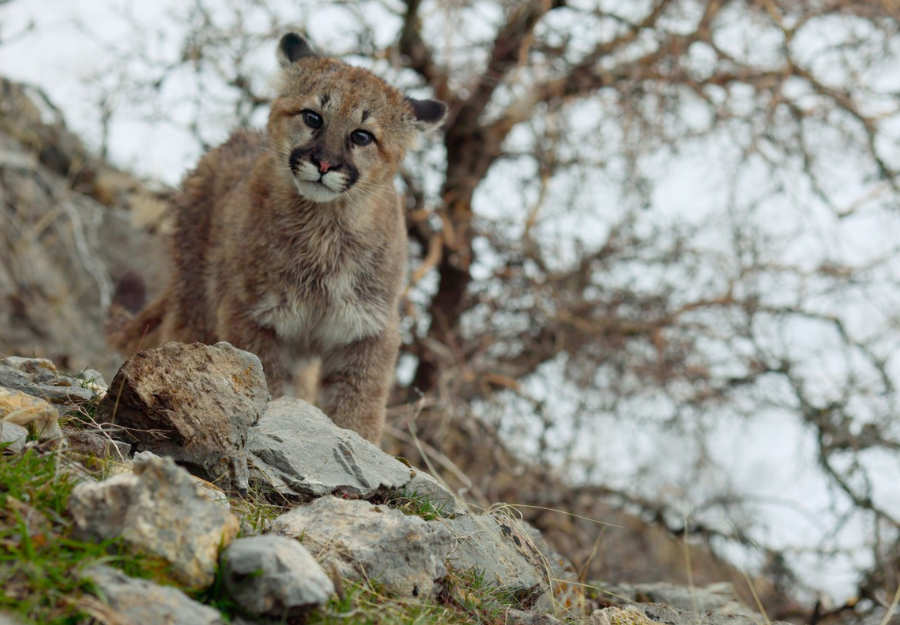Basic knowledge to ensure safety on the trail
As rare as a lightning strike is, you still wouldn’t set out to summit a peak with thunderheads rolling in. That’s simply not good practice.
Although encounters with mountain lions are quite rare, and attacks are even more uncommon—you’re actually much more likely to be hit by lightning — it’s still important to be equipped with knowledge.
Just as an understanding of mountain weather is important for your safety, anyone who recreates in mountain lion habitat should also have a good understanding of the biology and behavior of mountain lions.
To ensure your own safety and protect mountain lions, develop good outdoor habits that keep these behavioral traits in mind.
Mountain lions tend to spend the day in dense cover, and to hunt when deer are active, most often at dawn and dusk. While these are also the times that people like to take a walk — avoiding the midday sun — we have a responsibility to be sensible when we do so in mountain lion country.
Lions have keen eyesight, but they do not see the same way we do. They look for the shape and movement of their natural prey. With deer being lion’s preferred prey, it’s easy to see how a dog could be mistaken for prey. Keep pets on a leash and keep them close to you. It’s also important for people to look as human as possible. Wearing brightly contrasting clothing can help a lion distinguish you from its natural prey. Although lions do not see colors as we do, dark, mid-tone or drab woodsy colors will make you look more like a deer.
Additionally, be very alert when leaning down or bending over to play hide and seek, pick berries, or use the bathroom. Crouching or bending down in mountain lion country could make you look like prey. Before crouching, scan the area you are in carefully first and make some noise.
Lions cache their prey. If you run across a dead animal in the brush, steer clear. Don’t investigate or disturb the area. Lion will defend their cache and may stay in the area for weeks at a time.
Lions chase by instinct. If you are lucky enough to spot a lion, do not run away. Lions can sprint at speeds approaching 45 miles per hour, so outrunning them is not likely to happen and your running away could trigger a lion’s instinct to chase. Once a chase has begun, the lion is no longer able to think rationally or assess whether their target is a deer.
To be cautious, you can avoid jogging or mountain biking at dusk and dawn when mountain lions are most active. You can also sing, talk, give the occasional shout-out, or play a podcast on your phone’s speaker while you bike and jog to alert wildlife to your presence.
Lions rely on stealth and do not take unnecessary risks. If you encounter a mountain lion and it doesn’t run from you immediately, don’t jump to conclusions about the meaning of its behavior. Our brains are wired to be fearful of large felines, but a mountain lion is a lot like a house cat and wants the same thing that you do: to get away safely. On rare occasions it may view you as prey, but most likely sees you as a curiosity or threat.
Because mountain lions are ambush predators, most likely any time you see one, it isn’t hunting you. It may simply be curious about you or it may be preparing to defend offspring or a cached food source. Either way, your next steps will be to show that you are too scary to fight and that you are not an imminent threat to it or its babies.
Mountain lion body language is similar to that of a house cat. Look at its ears and eyes and body posture. If you saw a cat doing the same, would you be afraid it was about to scratch you? If so, be sure you’re far enough away that the lion can’t reach you. Back away, maintaining eye contact and shouting. Wave your arms and a towel, jacket, handkerchief, or walking stick to look bigger and scarier. Mountain lions will not turn their back on you if they view you as dangerous, because they know from their own hunting behavior that predators attack from behind. Give them room to run away.
A lion not backing down immediately doesn’t mean it is a threat to you. It is looking for an opening to leave safely, which can be a sign that you have the advantage.
Predators like the mountain lion cannot afford an injury. If they are hurt they cannot hunt effectively, defend their territory, or seek water and shelter. When injured, wild animals starve. But a sick or injured animal also may seek out easy prey and become much less interested in anything that looks like it will fight back. By making one big aggressive move early on — a loud shout or clap, even an aggressive step toward the lion when it’s undecided about its next step — you can give the lion the excuse it needs to exit. Mountain lions are generally scaredy cats and want exactly what you do: to exit an encounter quickly and safely.
Research has shown that mountain lions go out of their way to avoid other mountain lions, and humans — relying on wariness as their first defense, resorting to fights only when necessary to defend a territory or a litter of kittens.
The best way to ensure that both you and the lion may leave safely is for you to back away slowly while continuing to look as big and intimidating as possible, leaving the lion avenues of escape.
It’s important that a lion not feel cornered or separated from its kittens, or a cached kill. It will fight to reach — and protect — either. If a lion doesn’t take an easy exit, kittens or a cache may be the reason.
You may love mountain lions, but, if you see one, it’s important that you behave aggressively. Not only does being hit by a thrown rock hurt, but it makes it very clear to the cougar that you are not a deer or coyote. Like most wild animals, lions want to avoid humans. Their fear is healthy and should be encouraged, for their own safety.
While hiking in cougar country, keep their traits in mind and develop good outdoor habits to avoid an encounter that neither you, nor the cougar is keen to have.
Learn More
For more safety tips, visit Safety – On the Trail on our website.
And check out this Living with Lions webinar from August 2023, Hiking in Lion Country, with long-distance hiker Renee Patrick. A dedicated conservationist with more than 11,000 miles under her boots, Renee shared practical advice on how to hike safely through lion country and how to advocate for the protection of wildlife and wildlands.



 Facebook
Facebook Twitter
Twitter Send Email
Send Email


